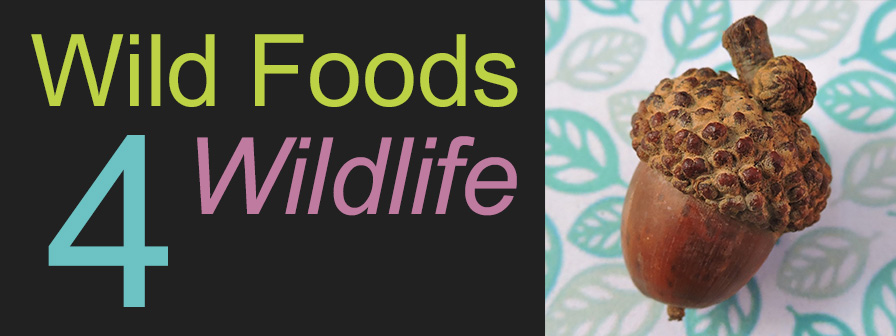Name: Dandelion, Common
Botanical Name: Taraxacum officinale
Form: wildflower
Parts Used: seeds, greens and flowers
Citation: Guenther, K. (2017, January 12) Common dandelion as wildlife food. [Web log post.] Retrieved: readers supply the date, from http://wildfoods4wildlife.com
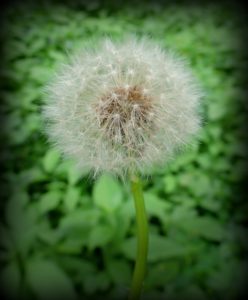
Getting Started
Dandelion is a highly useful green and seed to collect for the rehabber pantry. In part, this is due to the fact that most people can easily recognize dandelions and that they are accessible almost everywhere. Also, dandelion is highly nutritious.
Dandelions can be found in bloom, scattered here and there throughout the growing season. But if you want to collect a lot of seed and flower head all at once, look for that first large spring bloom before the first grass mowing of the season. I collect all my seed for the year right in that first, most substantial crop.
Seeds, greens and flowers are all utilized by wildlife. Greens are 11th in popularity on our Great Greens list, while seeds are 33rd in usage compared to other seed. But more than any other flower, dandelion flower petals are eaten by 12 known species of mostly birds. Also, the seeds are very easy to collect and process for birdseed.
We have two species in our area. Here’s the taxonomy:
Asteraceae (Aster family)
Cichoriodeae (Chicory/Dandelion subfamily)
Taraxacum (Dandelion genus)
| Common name | Virginia Taraxacum Species | Origin | Rare Plant Status |
| common dandelion | T. officinale | non-native | Not rare |
| red-seeded dandelion | T. erythrospermum | non-native | Not rare |
Virginia Botanical Associates. (Accessed February 4, 2016). Digital Atlas of the Virginia Flora (http://www.vaplantatlas.org). c/o Virginia Botanical Associates, Blacksburg.
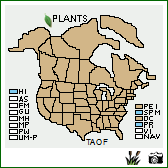
Key Features to look for
In addition to the identification guide of your choice, you should see all these features on dandelion to help you rule out look-alikes, of which there are a few:
- Leaves are always in a rosette on the ground—no leaves come out of the stems
- Leaf rib (back of leaf center axis) is generally hairless (but there could be a white wooly-looking bit)
- Only one yellow flower between the size of a quarter and a fifty cent piece per plant
- Hollow stem
- Flower “petals” are squared off, not pointed at the tips
- The leaf’s central axis in cross-section is rounded, no edge to it
- Usually one single, main tap root
- Reddish at the bottom of the leaf stem
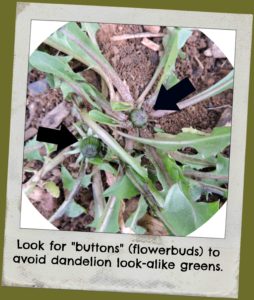
Risks
None indicated.
About this Species
Most everyone knows dandelion flowers. But identification solely off the leaf with no flower present can be more difficult. Dandelions do have look-alikes that can be difficult to distinguish, like Cat’s Ear and Hawkweeds, but thankfully none of the look-alikes are poisonous, so if you inadvertently harvest one it shouldn’t be a problem.[Note: Cat’s Ear Hypochaeris can lead to a condition called stringhalt in horses].
Read on to the bottom for some example of look-alikes. To differentiate dandelion look-alikes by leaf and stem only, see a wonderfully helpful key written by expert forager Samuel Thayer under the leaf section of this monograph.
Flower Description
The “petals” of the flower (which are actually ray flowers) have squared off tips that resemble a rectangle end, rather than a tapered pointed end. Sometimes this shape is referred to as a “strap”. The stalk or stem (peduncle) below the flower rises from a rosette of leaves at ground level. The green bracts underneath the sepals and flower head fold downward (recurved) like a jester’s collar. The bright yellow flowers are between the size of a quarter and a fifty cent piece.
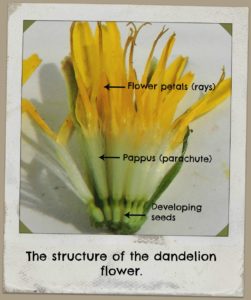
Leaf Description
Dandelion is named after the “tooth of the lion” because of the pointy, tooth-looking lobes along the leaf. Young leaves are rounder with less jagged teeth, older leaves are very jagged with deep indentations—that difference in contour related to age can lead to confusion. The leaf stalk is hollow and exudes a milky white latex when torn. Leaves grow from the base of the stem at the ground in a rosette. Often the stem is smooth and has tinges of red in it.
To identify dandelion by leaf and stem ONLY, Samuel Thayer wrote the following key that differentiates four different plant greens that can be offered to wildlife patients, cat’s ear (Hypochareis radicata), wild lettuce ( Lactuca spp.), field sow thistle (Sonchus arvenis) and dandelion (Taraxacum spp.). Also, chickory (Cichorium spp.) which is eaten as seed.
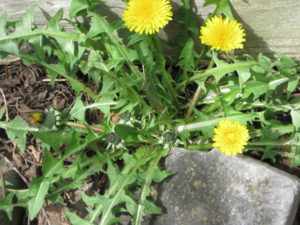
Key below from From Samuel Thayer’s in Nature’s Garden: A Guide to Identifying, Harvesting and Preparing Edible Wild Plants, used with permission.
Lettuce-Dandelion Group
(Focusing on leaf and stem features)
Start at the beginning of this key. Choose carefully which of the couplets describes your plant, proceeding until you have arrived at the correct genus.
1. All leaves long and narrow, grass-like, V-shaped in profile, margins smooth and entire; latex light brown: Tragopogon (salsify).
1. Leaves toothed, lobed, or with wavy or irregular margins: all others, go to 2.
2. Basal leaves borne on long petioles roughly equal to or longer than the blade; blade widens abruptly from the petiole. Blade and petiole form a 90-130 degree angle: Prenanthes.
2. Leaves clasping, sessile, or with proportionately short petiole; blade widens gradually: all others, go to 3.
3. Midrib cross-section forms a low, rounded hump on leaf underside: Taraxacum (dandelion), Cichorium (Chicory), or Hypochaeris (Cat’s ear), go to 4.
3. Midrib cross-section triangular, forming a sharp or nearly sharp keel: Lactuca ( lettuce) or Sonchus (sow thistle), go to 6.
4. Leaf generally without erect hairs (may be a very fine wool laying down, especially on the midvein): Taraxacum (dandelion.)
4. Leaf with notable erect hairs: Cichorium ( chicoey) or Hypochaeris(cat’s ear), go to 5.
5. Erect hairs on all leaf surfaces, almost evenly distrubited : Hypochaeris (cat’s ear).
5. Erect hairs most prominent on midvein especially below: Cichorium (chicory).
6. Erect hairs or spines found along the keeled bottom of the midvein, latex white or light brown: Lactuca (lettuce), except L. muralis.
6. Erect hairs or spines absent from bottom of the midvein; leaves with curved auricles at base where attached to stalk; latex white: Sonchus (sow thistle).
Seed/ Fruit Size
Seed with pappus parachute fluff is around 5/8 inch (15 mm) long. Seed after removal of fluff is around 5/32 inch (4 mm) long.

Harvest Calendar:
| Jan | Feb | Mar | Apr | May | Jun | Jul | Aug | Sep | Oct | Nov | Dec | ||||||||||||||
|---|---|---|---|---|---|---|---|---|---|---|---|---|---|---|---|---|---|---|---|---|---|---|---|---|---|
| winter | winter | late winter | early spring | spring | late spring | early summer | summer | late summer | early fall | fall | late fall | ||||||||||||||
| seeds | x | x | x | ||||||||||||||||||||||
| greens | x | x | x | x | x | x | x | x | x | x | x | x | x | x | |||||||||||
| flower | x | x | x | x | |||||||||||||||||||||
Dandelion can be found throughout the growing season, but these are the best dates for mass harvest.
A good enrichment item?
Not particularly.
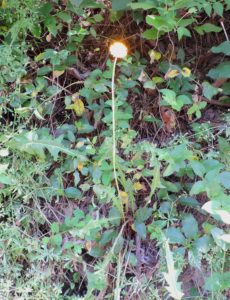
Nutrition
Dandelion greens are highly nutritious, rich in vitamin A, B, C, E, iron, phosphorus, potassium and calcium (Elpel, 2013). The bitterness provided by the milky latex acts as a digestive aid that helps “clean out” the liver.
Click on the following link for the nutrition fact labels for raw dandelion greens: calories, vitamins, minerals, proteins, carbohydrates, fats and fatty acids and other nutrients from the nutritional search engine www.SkipThePie.org
Harvesting Seed
There is a brief period in mid to late April when the first big flush of dandelion flowers go so seed en mass, about the same time that field mustard is at its peak. I wait for a warm, dry, windless day during that 1-2 week period and try to harvest all the seed I will want for the whole year. Dandelions will continue to grow, flower and go to seed throughout summer, but it will be more spotty and difficult to gather seeds in quantity. Harvest seeds when the seed head is fully open and you can see that the seeds are dark. The seeds should very easily detach from the flower if mature and ready for harvest.
Pull the stalk with the whole fully-open seed head through your hand and deposit the seeds and fluff inside a paper bag. Clip the bag closed or seed may waft out. Let dry a few days indoors. Wearing a dust mask and after completely dry, take a handful of seeds in your hands and vigorously rub the seeds together over a large bowl (outside) until the seed separates from the fluff. Discard the fluff. Seed separates from fluff pretty easily and cleanly.
Alternately, I like using seed cleaning screens. Wearing a dust mask, put the screen over a large bowl and rub the fluff around in circles so the seed falls through. Then change out screens to a smaller size and run the screen through again. There will be a little bit of dust left in with the seed. Electric fan or wind winnowing will finish the cleaning. (I don’t recommend blowing-breath winnowing for this plant because the fine dust will irritate your throat.)
This whole cleaning process took me less than 15 minutes.
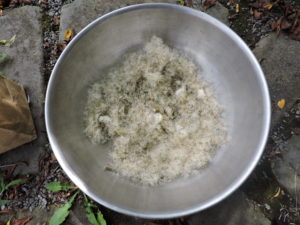
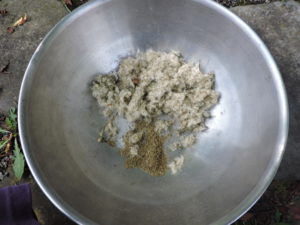
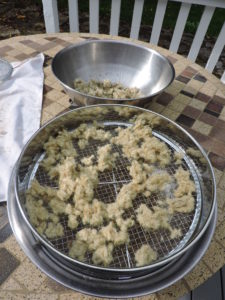
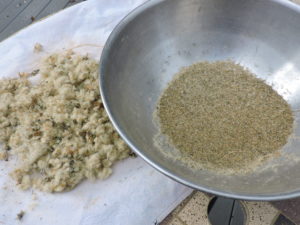
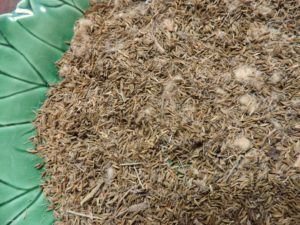
How to Store Prepared Seed
Once cleaned and fully dried, choose a low humidity day—not a rainy day—to jar up your seed.
Glass or metal works best, because all plastics are somewhat porous to humidity. Canning jars and lids work well. Place seed in a tightly sealed, glass container and store in a dark, cool area for up to 1 year. Refrigeration and freezing work well. Label the airtight container with the seed name, date of harvest and which animals it should be used for.
If you intend to keep the seed longer than one year, jar up the seeds in two stages. First, jar the seeds up using a desiccant for up to 1 week. Then check the seed for dryness, and if dry enough, remove the desiccant and immediately repack the seed into an airtight container. Read more about drying seeds and using desiccants under the tab “Food Harvest, Cleaning and Storage.”
Keep stored seed in an airtight glass or metal container in a cool, dark place. Refrigeration and freezing works well, but allow container to warm to room temperature before opening. Discard any seed that ever appears moldy.
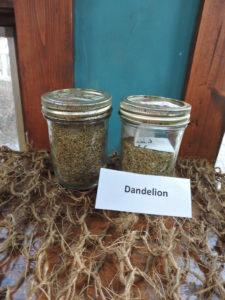
Harvesting Greens and Flowers
Green leaves can be harvested at anytime spring to fall, but are tastier and less fibrous when young and small in late spring. Small plants can be pulled up whole after a rain. By leaving the roots attached, the greens will stay fresher longer in the refrigerator, up to 1 week.
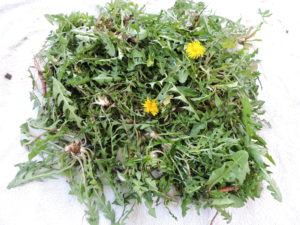
How to Store Prepared Greens
If you choose to, use a commercial vegetable cleaner or a ¼ cup (60 ml) of vinegar added to wash water as a cleaner. Submerge the plant material and swish it around to remove all dirt from leaves and roots. Rinse in clean water. Always wash greens; you never know what might be on them…like animal feces or urine. Place in a colander or salad spinner to drain, then layout a towel and spread the greens on the towel and roll up the towel. Unroll and transfer the damp greens to storage.
For storage, there are a couple of different possible container methods. If the greens will be used quickly within days, place the spun-and-towel-rolled damp greens to a 1 gallon ziploc baggie with 12-15 holes cut in it to provide air and keep the greens from molding (or reuse commercial grape bags with holes). Label the bag with the plant name and which animals it should be used for. Keep container in the vegetable drawer of the refrigerator.
For storage longer than one week, use a rigid, lidded, airtight container. After washing and salad spinning the greens, place a paper towel in the bottom, then loosely fill with greens, but do not pack them in. Then lay a paper towel on top and put on lid. Keep container in the vegetable drawer of the refrigerator. Do not use if greens become moldy, slimy or dried out.
Many greens are very sensitive to exposure to ethylene gas, though greens themselves are low emitters of the gas. You may get longer quality by adding with a product that reduces free ethylene gas in the refrigerator. Greens are good until they become dry and crispy, fad in color, or become slimy or moldy.
Read more about storing leafy greens at “Food Harvest, Cleaning and Storage.”
How to Store Prepared Fresh Flowers
Clip flower heads off stems and submerge in cold water. Offer as soon as possible to animals. Quality is likely to deteriorate within days.

Other Species
As mentioned, there are a good number of dandelion green lookalikes that are emerging from the ground right when dandelion emerges in the spring, and often in the same areas. What makes dandelion leaves even more confusing to identify is that the leaf shape changes somewhat as the plant matures. To make sure I don’t pick a wrong species when I am hurrying along, I always look for the little telltale button bud of the flower in the center of the leaf rosette. If I don’t see that, I slow down and double check for other identification tips about the leaf.
- Leaf rib (back of leaf raised center axis) is hairless (but there could be a white wooly-looking bit).
- The leaf rib in cross-section is rounded, no edge to it.
- Reddish at the bottom of the leaf stem.
I found these 3-4 plants all growing alongside dandelion in March when I was harvesting.
To me, the most “look-alike-y” of the look-alikes is cat’s ear (Hypochoeris radicata). On dandelion flower, the green bracts underside where the flower meets the stem are recurved like a jester’s collar. On cat’s ear the bracts grow upward in plane with the sepals and ray flowers. Cat’s ear leaves are very hairy on both side of the leaf, dandelion leaves are hairless.
But there are other look-alikes as well: Hawkweeds of the Hieracium genus, hawksbeards of the Crepis genus, dwarf dandelions of the Krigia genus, or hawkbits of the Leontodon genus. Even coltsfoot flowers could fool some folks.
And another thing. Be aware that grocery stores are starting to stock “Italian dandelion” greens. These are a related to dandelion, but are a different genus and species, Cichorium intybus, whose common name is either Catalogna chicory or San Pasquale chicory. I’m sure you can feed those safely to animals, but they are not native greens. Just so ya know.
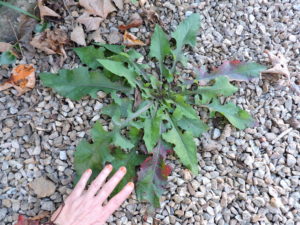
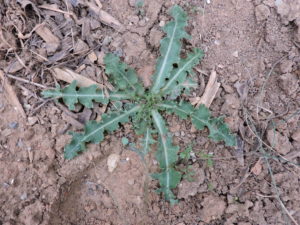
Rare Species in Virginia
There are no threatened or endangered dandelion species in the eastern half of the United States.
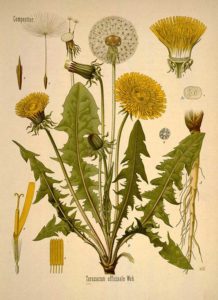
Feed Dandelion to:
dandelion, common | (Taraxacum officinale) | flowers/buds/catkins |
|---|---|---|
Bear, American Black | Ursus americanus |
|
Deer, White-tailed | Odocoileus virginianus |
|
Elk, Rocky Mountain | Cervus elaphus |
|
Finch, House | Carpodacus mexicanus |
|
Goldfinch, American | Carduelis tristis |
|
Meadowlark, Eastern | Sturnella magna |
|
Oriole, Baltimore | Icterus galbula |
|
Tanager, Scarlet | Piranga olivacea |
|
Tanager, Summer | Piranga rubra |
|
Warbler, Yellow | Dendroica petechia |
|
Grouse, Sharp-tailed | Tympanuchus phasianellus |
|
dandelion, common | (Taraxacum officinale) | greens |
Deer, White-tailed | Odocoileus virginianus | strong preference |
Bear, American Black | Ursus americanus |
|
Cottontail, Eastern | Sylvilagus floridanus |
|
Elk, Rocky Mountain | Cervus elaphus |
|
Vole, Pine | Microtus pinetorum |
|
Voles, various spp. | various species |
|
Dickcissel | Spiza americana |
|
Finch, House | Carpodacus mexicanus |
|
Goldfinch, American | Carduelis tristis |
|
Bobwhite, Northern | Colinus virginianus |
|
Grouse, Ruffed | Bonasa umbellus |
|
Grouse, Sharp-tailed | Tympanuchus phasianellus |
|
dandelion, common | (Taraxacum officinale) | seeds |
Vole, Pine | Microtus pinetorum |
|
Voles, various spp. | various species |
|
Bunting, Indigo | Passerina cyanea |
|
Cowbird, Brown-headed | Molothrus ater |
|
Finch, House | Carpodacus mexicanus |
|
Goldfinch, American | Carduelis tristis |
|
Nuthatch, Red-breasted | Sitta canadensis |
|
Nuthatch, White-breasted | Sitta carolinensis |
|
Redpoll, Common | Carduelis flammea |
|
Siskin, Pine | Carduelis pinus |
|
Sparrow, Chipping | Spizella passerina |
|
Sparrow, House | Passer domesticus |
|
Sparrow, Song | Melospiza melodia |
|
Sparrow, Vesper | Pooecetes gramineus |
|
Sparrow, White-crowned | Zonotrichia leucophrys |
|
Bobwhite, Northern | Colinus virginianus |
|
Grouse, Ruffed | Bonasa umbellus |
|
Grouse, Sharp-tailed | Tympanuchus phasianellus |
|
Online References
Esser, Lora L. 1993. Taraxacum officinale. In: Fire Effects Information System, [Online].
U.S. Department of Agriculture, Forest Service, Rocky Mountain Research Station, Fire Sciences Laboratory (Producer).
Available: http://www.fs.fed.us/database/feis/plants/forb/taroff/all.html [2016, December 24].
USDA, NRCS. 2015. The PLANTS Database (http://plants.usda.gov, Accessed 4 February 2016). National Plant Data Team, Greensboro, NC 27401-4901 USA.
Virginia Botanical Associates. (Accessed February 4, 2016). Digital Atlas of the Virginia Flora (http://www.vaplantatlas.org). c/o Virginia Botanical Associates, Blacksburg.
Book References
Elpel, T.J. (2013) Botany in a Day (APG). Pony, Montana: Hops Press, LLC.
Martin, A.C., Zim, H.S., Nelson, A.L. (1951). American Wildlife and Plants: A Guide to Wildlife Food Habits. New York: Dover Publications.
Scott, M. (2013). Songbird Diet Index. National Wildlife Rehabilitators Association, St. Cloud, MN.
Thayer, S. (2010). Nature’s Garden: A Guide to Identifying, Harvesting and Preparing Edible Wild Plants. Birchwood, Wisconsin: Forager’s Harvest Press.
